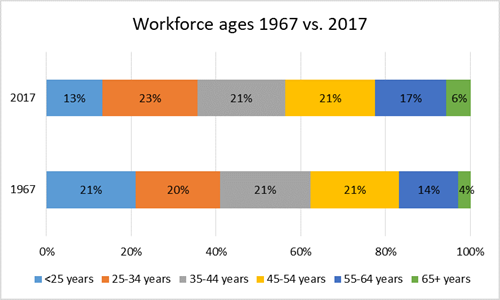Defining Age Discrimination and How to Avoid It
Baby Boomers were just children when the Age Discrimination in Employment Act (ADEA) was enacted half a century ago, but violations of the groundbreaking legislation still occur all too often in today’s workforce.
The Age Discrimination in Employment Act
The ADEA protects applicants and employees who are 40 years of age or older from employment discrimination and harassment based on age. Any employment action, including hiring, firing, promotion, layoff, compensation, benefits, job assignments, and training based on age is prohibited.
Employers also are prohibited for retaliating against an employee who files a complaint. The law applies to all governmental, state, and federal employers regardless of their number of employees, as well as private employers with 20 or more employees.
The ADEA was one of the sweeping employment laws, along with the Equal Pay Act of 1963 and the Civil Rights Act of 1964, enacted by Congress in the 1960s to protect workers from discrimination and enhance employment opportunities.
The law was initially enforced by the Department of Labor (DOL), but, since 1979, has been enforced by the Equal Employment Opportunity Commission (EEOC).
The Older Workers Benefit Protection Act (OWBPA) amended the ADEA to specifically prohibit employers from denying benefits to older workers. Congress recognized the cost of providing certain benefits to older workers is greater than the cost of providing those same benefits to younger workers and passed the OWBPA in 1990.
Examples of age discrimination include:
- Failing to promote older workers
- Repeatedly asking questions regarding retirement plans
- Denying training opportunities to older workers
- Targeting younger workers in recruiting ads (such as wanting a young, energetic workforce)
- Asking an applicant’s age, date of birth, or date of high school graduation
- Disciplining older workers for actions not addressed with younger workers
- Targeting older workers in a reduction in force at a higher proportionate rate than younger workers
50 Years Later
The EEOC recently issued a report titled The State of Age Discrimination and Older Workers in the U.S. 50 Years after the Age Discrimination in Employment Act.
The report found the share of workers ages 55 and older has grown considerably in the last 25 years. It also stated today’s workforce has doubled in size, and is older, more diverse, more educated and more female than it was 50 years ago. Women ages 55 and older are projected to make up more than 25 percent of the female labor force by 2024.

The majority of older workers believe age discrimination still exists in the workplace. According to a study conducted by AARP, more than 6 in 10 workers aged 45 and older say they have seen or experienced age discrimination. Of those, 90 percent say it’s somewhat or very common. Although older workers say they’ve seen or experienced age discrimination, only approximately 3 percent report it in a formal complaint.
Age discrimination is particularly difficult for older workers pursuing employment. The largest and most recent study on this issue was conducted in 2015 by the University of California at Irvine and Tulane University. Researchers created about 40,000 fake applications for over 13,000 jobs in 12 cities across 11 states. They discovered older workers, particularly those ages 64 to 66, were more frequently denied job interviews than workers ages 49 to 51. Women, especially older and middle aged women, were subjected to age discrimination more than older men.
Complaints Continue
The EEOC received 18,376 charges of age discrimination during fiscal year 2017 and collected $90.1 million. As mentioned earlier, it estimated those are only a fraction of likely discriminatory conduct, mainly because age discrimination is often difficult to prove.
There have been complaints against industry giants, including IBM, IKEA, Amazon, T-Mobile and hundreds of others. The Communication Workers of America has filed a class-action lawsuit aimed at companies using Facebook’s ad targeting tools that filters out candidates based on age, gender and geography.
In other actions, Texas Roadhouse recently paid $12 million for denying applicants front of house positions based on age, using advertisements or material related to these positions that indicate preference based on age.
School Districts
School districts aren’t immune to age discrimination. Based on information available from the U.S. Department of Education, as of July 27, 2018, there are 122 pending age discrimination cases nationwide for age discrimination in elementary, secondary, and post-secondary educational institutions. In August, the EEOC announced it was filing a suit against an Illinois district for limiting pay increases to teachers based on age.
Ways to Avoid Age Discrimination
Here are a few tips to avoid wage discrimination:
- Provide age discrimination training. Be sure to cover unconscious biases and stereotypes about older and younger workers.
- Consider ability, not age, in making employment decisions. This includes hiring, promotions, training opportunities, and other actions.
- Don’t assume some workplace responsibilities and training activities can only be done by younger workers.
- Don’t approach layoffs in terms of pay and experience.
For more information on the ADEA and other discrimination laws, visit the HR Library.
HR Services

Subscribe to HRX
Stay up to date with all the latest HR news and trends by joining the HRX mailing list!





